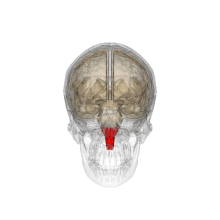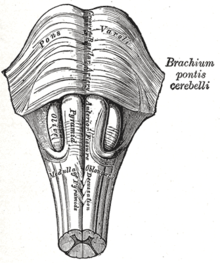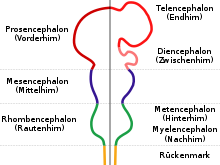Medulla oblongata
The medulla oblongata, or medulla oblongata, is the most caudal (posterior or inferior) part of the brainstem and is part of the brain and thus the central nervous system.
This area of the brain is anatomically also called the myelencephalon (medullary brain), other names are afterbrain and bulbus medullae spinalis, bulbus cerebri or bulbar brain. Together with the metencephalon (hindbrain), the myelencephalon forms the rhombencephalon (diamond brain). The medullary brain or medulla oblongata is not sharply delineated caudally at the junction with the spinal cord (medulla spinalis). By definition, it extends from the exit of the first pair of spinal nerves - approximately at the level of the foramen magnum - up to the bridge (pons) of the hindbrain; in adult humans it is about three centimeters long.
In the medulla oblongata lie the vital centres for the regulation of respiration (respiratory centre) and blood circulation and others through which reflexive reactions can be triggered: nutritive ones such as the sucking reflex and swallowing reflex, but also protective ones such as the cough reflex, sneezing reflex, gag reflex and vomiting (see also vomiting centre). Chemosensors are also found in the medulla oblongata itself, for example for acid-base status in the body. In addition, all pathways connecting other brain areas, such as the cerebrum, to the spinal cord run descending through the medulla oblongata. Conversely, pathways ascending from the spinal cord, such as those from the hindbrain, are switched in the medulla.
Failure of the medulla oblongata, for example in the case of severe injuries to the cervical spine, usually leads to death. On the other hand, a person in whom only the cerebrum is largely or completely non-functional (partial brain death) can continue to live physically with the help of the functions regulated in the intact medulla oblongata. Since the centers for respiration are located here, such a patient does not require artificial respiration, except in crises. The patients are in deep coma and usually show apallic syndrome. In the case of disorders of the upper brainstem, the term midbrain syndrome is used, and in the case of failure of brainstem functions in the area of the medulla oblongata, the term bulbar brain syndrome is used.

rotation animated brain model, medulla oblongata marked in red
_section_description.JPG)
Frontal section of a human brain. Area /5/ - Medulla oblongata

Lower brain stem with pons and medulla oblongata

Stages of brain development from the anterior neural tube: The rhombencephalon of the 3 vesicle stage (left) differentiates into the metencephalon and the myelencephalon, from which the medulla oblongata arises, adjacent to the spinal cord.
Outline
In the medulla oblongata or myelencephalon, a slender lower section similar to the spinal cord can be distinguished around the central canal, as well as - with its widening to the IV cerebral ventricle - a broad upper section, which lies as if folded open at the bottom of the lower rhomboid fossa and shows a different structure. Here the grey matter then takes up the entire width as a tegmentum (cap), is loosened up in a net-like manner as a formatio reticularis and contains embedded in it numerous nuclear areas, so also nuclei of the cranial nerves (V, VII-XII) in functional order from the middle to the outside.
Ventrally superimposed on the medullary canopy on each side is an area of white matter in which mainly descending tracts run, and which externally on both sides of the anterior longitudinal furrow throws up a protrusion called a pyramis (pyramid). These downward slender pyramids are connected in the caudal region as decussatio pyramidum (pyramidal crossing), where a great many nerve fibers cross from one side to the other, such as most of the pyramidal tracts from the cerebral cortex for muscle movements. The median line between the two halves is therefore also called the raphe (suture).
As the lowest cranial nerve, the motor XII. The hypoglossal nerve emerges anteriorly from the medulla oblongata, between the pyramid and a lateral thickening called the oliva (olive). This contains the nuclei olivares (olive nuclei) of the medulla, a nuclear complex in which main nucleus (nucleus olivaris principalis; also called "olive") and accessory nuclei (nuclei olivares accessorii medialis et posterior; also called "accessory olives") are distinguished.
In the inferior olive (nucleus olivaris inferior) in the medullary brain, projections from other brain areas and proprioceptive ones from the spinal cord are combined and switched to next neurons. From here, pathways travel to the cerebellum, which plays a central role in the coordination of muscle movements, especially fine motor movements.
Questions and Answers
Q: What is the medulla oblongata?
A: The medulla oblongata is the lower half of the brainstem located just on top of the spinal cord.
Q: What does the medulla oblongata connect?
A: The medulla oblongata connects the higher parts of the brain to the spinal cord.
Q: What are the cardiac, respiratory, and vasomotor control centers?
A: The cardiac, respiratory, and vasomotor control centers are parts of the medulla oblongata that control heart rate, blood pressure, breathing, and the size of the body's blood vessels.
Q: Why is the medulla oblongata important?
A: The medulla oblongata is important because if it did not work, the person would die.
Q: What happens if the medulla oblongata controls centers stop functioning properly?
A: If the medulla oblongata controls centers stop functioning properly, the person's heart rate, blood pressure, breathing, and the size of the body's blood vessels may be affected, and they may die.
Q: How does the medulla oblongata control the body's blood vessels?
A: The medulla oblongata controls the size of the body's blood vessels.
Q: What is the location of the medulla oblongata in the human brain?
A: The medulla oblongata is located in the lower half of the brainstem.
Search within the encyclopedia